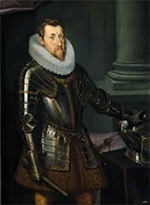Ferdinand II: King of Germany, Holy Roman Emperor
Part 1: Empires and Conflicts Ferdinand II was King of Germany and Holy Roman Emperor for a time in the first half of the 17th Century. He was notably on the throne during the early fighting of the Thirty Years War. 
He was born on July 9, 1578, in Graz, in the Austrian duchy of Styria. His father was Archduke Charles II of Austria, and his mother was Maria Anna of Bavaria. Importantly for Ferdinand's future, his parents were both devout Catholics. In 1564, Charles II had gained ascendancy in Inner Austria, a set of provinces that included parts or all of Carinthia, Carniola, Fiume, Friuli, Gorizia, Istria, and Trieste. This occurred at the death of his father, the Holy Roman Emperor Ferdinand I. Ferdinand was 12 when his father died, and a battle ensued over the youth's guardianship and regency. Ultimately, Rudolf II, the head of the Habsburg family, appointed his brother Ernest (and later another brother, Maximilian) to guide Ferdinand, who meanwhile was completing his studies at a Jesuit college in Bavaria. Ferdinand came of age to rule in his own right in 1596 and set about strengthening his realm's defenses against an increasingly encroaching Ottoman Empire. He also began a policy of appointing only Catholics to state positions. Europe at this time was still in the wake of a religious revolution. The Protestant Reformation had thrived for a few decades by this time, and the Catholic Church had responded with the Counter Reformation. Ferdinand played his part in this by treading a careful line between keeping the peace and maintaining the (Catholic) faith. On April 23, 1600, Ferdinand married Maria Anna of Bavaria. They had seven children, four of whom lived into adulthood: Ferdinand (1608), Maria Anna (1610), Cecilia Renata (1611), and Leopold (1614). Rudolf had lost credibility with many of his subjects, including powerful nobles, by this time, and he had to hand over the thrones of Austria and Hungary to Matthias. He included the Bohemian crown two years later, after trying to play both sides of the Catholic-Protestant division and succeeding only in alienating both Bohemian Catholics and Bohemian Protestants. Further, in 1611, Matthias led an army into Rudolf's castle in Prague and held the emperor prisoner. By this time, Matthias was clearly the power behind the throne. Rudolf, thus imprisoned and stripped of his effectiveness, died, on Jan. 20, 1612. It was on that day that Matthias technically became Holy Roman Emperor, although he was officially recognized as such two weeks later. Ferdinand had been Archduke of Austria since 1590. He was firmly in charge of the Austrian lands by the time that Matthias had seized power from Rudolf. In fact, he attempted mediation between the two brothers but was rebuffed. Matthias adopted Ferdinand as his son but refused to support his being elected King of the Romans. Eventually, Matthias made the designation. Next page > A Continent at War > Page 1, 2 |
|
Social Studies for Kids
copyright 2002–2026
David White




